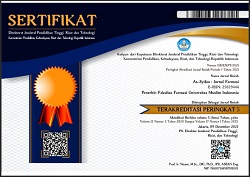KARAKTERISASI ISOLAT BAKTERI PENGHASIL SELULOSA DARI BUAH NAGA MERAH (Hylocereus polyrhizus)
Abstract
Cellulose is a natural polymer widely used for general industrial purposes. The development of science utilizes bacteria from certain fruits to produce biosellulose. Red dragon fruit (Hylocereus polyrhizus) contains a lot of sugar which can be bioconverted to cellulose by cellulose- producing lines. The research aimed to obtain bacteria from red dragon fruit with the potential to produce cellulose, then conduct morphological and biochemical characterization. The research was conducted by the isolation of bacteria from the fruit, purification, and screening tests using Hestrin-Schramm medium. The isolates obtained were characterized morphologically through macroscopic and microscopic observation and the biochemically through catalase test, carbohydrate fermentation, starch and gelatin hydrolysis, motility, and IMViC (Indole, Methyl red, Voges- Proskauer, Citrate). The results showed that 4 bacterial isolates had the potential to produce cellulose. Based on Bergey's Manual of Systematic Bacteriology, 3 bacterial genera were obtained, namely Acetobacter, Gluconacetobacter, and Azotobacter. The results of the characteristics of the isolates obtained at IBBN 2-2 were positive in the catalase test, sucrose and lactose fermentation, and methyl red. IBBN 3-1 was positive in the catalase test, sugar fermentation, starch hydrolysis, methyl red, and citrate. IBBN 3-2 was positive in the sucrose and glucose fermentation test, gelatin hydrolysis and 4-1 IBBN was positive in the sucrose fermentation test and gelatin hydrolysis.
Keywords
Full Text:
PDF (Bahasa Indonesia)References
Bahri S. Pembuatan Pulp dari Batang Pisang. J Teknol Kim Unimal. 2017;4(2):36.
Adebayo-Tayo B, Akintunde M, Sanusi J. Effect of Different Fruit Juice Media on Bacterial Cellulose Production by Acinetobacter sp. BAN1 and Acetobacter pasteurianus PW1. J Adv Biol Biotechnol. 2017;14(3):1–9.
Rangaswamy BE, Vanitha KP, Hungund BS. Microbial Cellulose Production from Bacteria Isolated from Rotten Fruit. Int J Polym Sci. 2015;2015.
HS S, Sampepana E, Susanty A. Pengaruh Rasio Buah Naga Merah (Hylocereus polyrhizus) dan Sukrosa Serta Lama Waktu Osmosis Terhadap Sifat Kimia Sari Buah Naga Merah (Hylocereus polyrhizus). J Ris Teknol Ind. 2017;11(2):123–30.
Warisno, Dahana K. Bertanam Buah Naga. Jakarta: PT. Gramedia Pustaka Utama; 2008.
Hungund BS, Gupta SG. Improved production of bacterial cellulose from Gluconacetobacter persimmonis GH-2. J Microb Biochem Technol. 2010;2(5):127–33.
Raj J. Isolation , Screening , and Characterisation of Cellulolytic Bacteria , Determination of Their Cellulolytic Potential. Int J Adv Res Ideas Innov Technol. 2017;3(4):215–20.
Cappuccino JG & SN. Manual Laboratorium Biologi. Jakarta: EGC; 2014.
Liempepas A, Lolo WA, Yamlean PVY. Isolasi dan uji antibakteri dari isolat bakteri yang berasosiasi dengan spons Callyspongia aerizusa Serta Identifikasi Secara Biokimia. Pharmacon. 2019;8(2):380.
Yulvizar C. Isolasi dan Identifikasi Bakteri Probiotik pada Rastrelliger sp. Isolation and Identification of Probiotic Bacteria in Rastrelliger sp. Biospecies. 2013;6(2):1–7.
Yanti AN, Ambardini S, Ardiansyah, Marlina WOL, Cahyanti DK. Antibacterial Activity of Soursoup Leaves Kombucha (Annona muricata L.) With Different Sugar Concentration. J Berk Saintek. 2020;3(2):35–40.
Costa AFS, Almeida FCG, Vinhas GM, Sarubbo LA. Production of bacterial cellulose by Gluconacetobacter hansenii using corn steep liquor as nutrient sources. Front Microbiol. 2017;8(OCT):1–12.
Garrity GM. Bergey’s Manual® of Systematic Bacteriology: Volume 2: The Proteobacteria ... - Google Books [Internet]. USA: Springer; 2010. Available from: https://books.google.lk/books?id=5zSYmcq0GdgC&pg=PA341&dq=virulence+factors+caused+by+pseudomonas+aeruginosa&hl=en&sa=X&ved=0ahUKEwjCu4XIjevOAhWBM48KHZwoAG8Q6AEIKTAD#v=onepage&q=virulence factors caused by pseudomonas aeruginosa&f=false
DOI: https://doi.org/10.56711/jifa.v13i1.770
Refbacks
- There are currently no refbacks.
Indexed by:
ISSN: 2085-4714 | e-ISSN: 2502-9444
Editor's Address:
Faculty of Pharmacy, Univeristas Muslim Indonesia
2nd Campus of UMI: Jl. Urip Sumoharjo km. 5 , Makassar, South Sulawesi, Indonesia
E-mail: jurnal.farmasi@umi.ac.id















